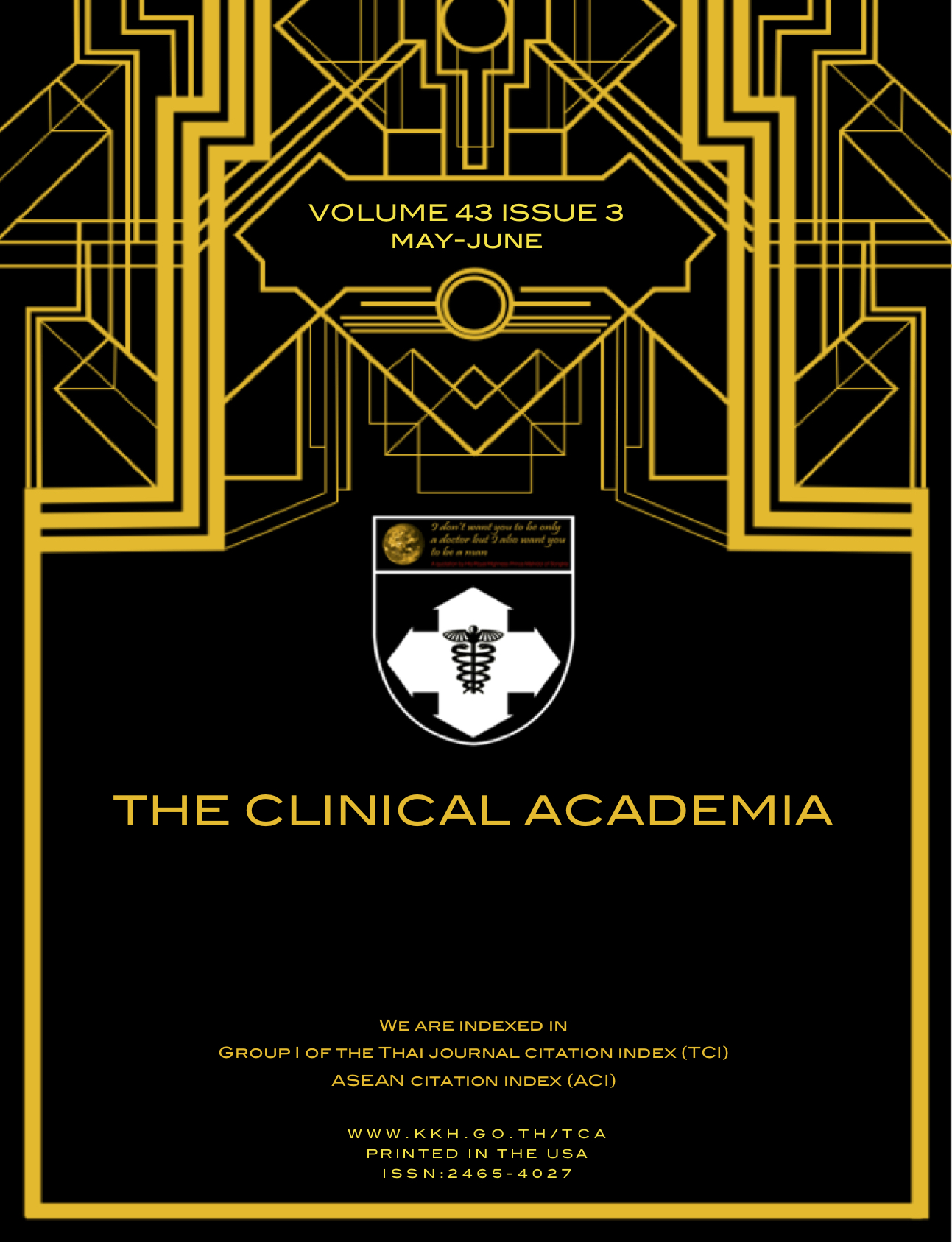Topical Sucralfate Ointment for Postoperative Pain Reduction after Hemorrhoidectomy: Systematic Review
บทคัดย่อ
ABSTRACT
BACKGROUND
Topical sucralfate ointment recently shows efficacy for postoperative pain reduction after hemorrhoidectomy. However, no systematic review compares the efficacy between topical sucralfate ointment and other topical treatments for postoperative pain reduction after hemorrhoidectomy.
METHODS
Three independent reviewers systematically searched through electronic databases including Cochrane library, Pubmed, Trip Database and Scopus using the term “hemorrhoidectomy” or “post hemorrhoidectomy pain” together with “topical sucralfate ointment”. Furthermore, we also sought for additional studies using a hand searching to identify all relevant randomized controlled trials (RCT) that comparing effect of topical sucralfate ointment and other topical treatments for postoperative pain reduction after hemorrhoidectomy. We included RCT with patients undergoing hemorrhoidectomy and using topical sucralfate ointment. We used Jadad score and The Cochrane Collaboration’s Tool for Assessing Risk of Bias to assess the quality of the included RCTs. Furthermore, we extracted the data from the included trials and we later performed the meta-analysis where possible.
RESULTS
Two RCTs were included in the meta-analysis with 138 patients undergoing hemorrhoidectomy; topical sucralfate ointment (N=69) and placebo (N=69). Topical sucralfate ointment had similar effect for pain score reduction to that of placebo at day 7 after hemorrhoidectomy (mean difference (MD) -0.47; 95% confidence interval (CI), -2.01 to 1.07; I2 =88%) and at day 14 after hemorrhoidectomy (MD -0.16; 95% CI, -1.98 to 1.67; I2=92%). Furthermore, patients in sucralfate group requested less daily amount of diclofenac than in placebo group at day 7 after hemorrhoidectomy (MD -64.58; 95% CI, -110.61 to -18.56; I2=92%), but not at day 14 after hemorrhoidectomy (MD -54.25; 95% CI, -113.51 to 5.01; I2=96%).
CONCLUSION
In patients undergoing hemorrhoidectomy, comparing efficacy between using topical sucralfate ointment and placebo for postoperative pain reduction after hemorrhoidectomy at day 7 cannot be concluded as our review had low volume of studies and participants as well as high heterogeneity.
เอกสารอ้างอิง
Thomson WHF. The nature of haemorrhoids. British Journal of Surgery 1975;62(7):542–52.
Riss S, Weiser FA, Schwameis K, et al. The prevalence of hemorrhoids in adults. International Journal of Colorectal Disease 2011;27(2):215–20.
Kaidar-Person O, Person B, Wexner SD. Hemorrhoidal Disease: A Comprehensive Review. Journal of the American College of Surgeons 2007;204(1):102–17.
Rivadeneira DE, Steele SR, Ternent C, Chalasani S, Buie WD, Rafferty JL. Practice Parameters for the Management of Hemorrhoids (Revised 2010). Diseases of the Colon & Rectum 2011;54(9):1059–64.
Lohsiriwat V. Hemorrhoids: From basic pathophysiology to clinical management. World Journal of Gastroenterology 2012;18(17):2009.
Nienhuijs SW, Hingh IHD. Conventional versus LigaSure hemorrhoidectomy for patients with symptomatic Hemorrhoids. Cochrane Database of Systematic Reviews 2009;
Hassan A, Mamun AA. Surgical Anatomy of Anal Canal and Rectum. Benign Anorectal Disorders 2016;:1–6.
Moote, Carol. "Efficacy of Nonsteroidal Anti-Inflammatory Drugs in the Management of Postoperative Pain." Drugs 44.Supplement 5 (1992): 14-30. Print.
Furlan AD. Opioids for chronic noncancer pain: a meta-analysis of effectiveness and side effects. Canadian Medical Association Journal 2006;174(11):1589–94.
Sucralfate. New England Journal of Medicine 1992;326(12):836–7.
Guslandi, M. "Sucralfate in Nonulcer Dyspepsia, Gastritis, and Duodenitis." Sucralfate (1995): 317-22.
Dajani EZ. Is peptic ulcer a prostaglandin deficiency disease? Human Pathology 1986;17(2):106–7.
Tryba M, Mantey F. Antibacterial activity of sucralfate in human gastric juice. Am J Med 1987;83(Suppl. 313):125–7.
Hayashi, A.h., H.y.c. Lau, and D.a. Gillis. "Topical Sucralfate: Effective Therapy for the Management of Resistant Peristomal and Perineal Excoriation." Journal of Pediatric Surgery 26.11 (1991): 1279-281. Print.
Banati A, Chowdhury SR, Mazumder S. Topical use of Sucralfate Cream in second and third degree burns. Burns 2001;27(5):465–9.
Szabo S, Petter Y, Eric S. Role of vascular factors including angiogenesis in the action of sucralfate. Am J Med 1991;91(Suppl. 2A):158–60.
Ala S, Saeedi M, Eshghi F, Rafati M, Hejazi V, Hadianamrei R. Efficacy of 10 % Sucralfate Ointment in the Reduction of Acute Postoperative Pain After Open Hemorrhoidectomy: A Prospective, Double-Blind, Randomized, Placebo-Controlled Trial. World Journal of Surgery 2012;37(1):233–8.
Albatanony A. Sucralfate ointment reduces pain and improves healing following haemorrhoidectomy: a prospective, randomized, controlled and double-blinded study. The Egyptian Journal of Surgery 2016;35(2):102.
Appendix: Jadad Scale for Reporting Randomized Controlled Trials. Evidence-based Obstetric Anesthesia :237–8.
Poulsen SS. Does Epidermal Growth Factor Play a Role in the Action of Sucralfate? Scandinavian Journal of Gastroenterology 1987;22(sup127):45–9.
Gupta, Pravin J., Purushottam S. Heda, Subhash A. Shrirao, and Surekha S. Kalaskar. "Topical Sucralfate Treatment of Anal Fistulotomy Wounds: A Randomized Placebo-Controlled Trial." Diseases of the Colon & Rectum 54.6 (2011): 699-704.
Gupta PJ, Heda PS, Kalaskar S, Tamaskar VP. Topical Sucralfate Decreases Pain After Hemorrhoidectomy and Improves Healing: A Randomized, Blinded, Controlled Study. Diseases of the Colon & Rectum 2008;51(2):231–4.
Freeman, Stephen B., and Lcdr J. Kevin Markwell. "Sucralfate in Alleviating Post-Tonsillectomy Pain." The Laryngoscope 102.11 (1992): 1242-246.



